International Nurses Day is celebrated on Friday 12 May – the anniversary of Florence Nightingale’s birth. Her advocacy and contribution to health care saved countless lives by making hospitals safer places to be. Nightingale advocated strongly for the role of nurses and equally for the recognition of their contribution to the care and recovery of patients.
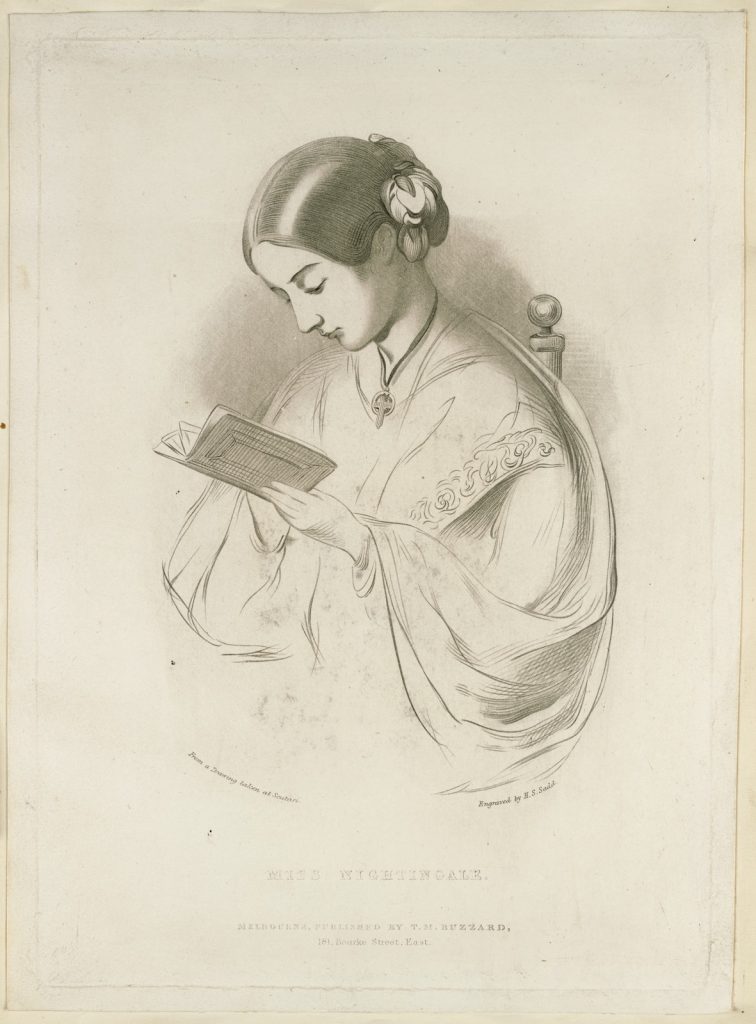
Melbourne, [Victoria] : T. M. Buzzard, H86.4/15
Her experiences in the Crimean War, and working to reduce the shocking – and often preventable – mortality rates were foundational to her development of the principles of nursing and embedding the rituals and traditions from the military setting into the medical realm.
The militaristic flavour introduced by Nightingale was not centred on a career of heroism as it was for the soldier. Rather it was based on the administrative adeptness of the ‘good housekeeper’. Nightingale was able to establish nursing as an acceptable occupation for women by aligning it with their perceived ‘normal’ and ‘natural’ traditional domestic role…the organising concepts around which Nightingales vision for nursing was to rely [were] discipline, subordination, surveillance, punishment, training and regimentation. Her aim was transform a new recruit into an efficient nursing machine.
Cordery, C., 1996, ‘Military influences on Nightingale’s reforms of modern nursing: the dominance of ritual and tradition’ Jeanette Covacevich … [et al].,eds, History heritage and health, p 195
Funded by donations to the Nightingale Fund, the introduction of a training course at St Thomas’s Hospital, London, in 1860, supported the development of nursing as a profession. Nightingale’s Notes on nursing: what it is and what it is not was first published in January 1860, with further editions and multiple reprints to follow. In it, she sets out her views on the principles and practices a good nurse should aspire to, however as stated in her preface, acknowledging that every woman is at some stage in charge of the personal health of somebody ‘I do not pretend to teach her how, I ask her to teach herself, and for this purpose I venture to give her some hints.’1

The volume covered all aspects of the above considerations, patient comfort, of observation in caring for the sick and strategies for dealing with ‘the chattering hopes – the bane of the sick.’
For those that were injured, or fell ill, in the early days of European settlement at Port Phillip, options were few. The Melbourne Hospital dating from 1848, was soon outgrown. People with means were nursed at home and hospitals were the ‘sanctuary for the sick poor.’2
Save for learning on the job, there was no structured training available for nurses until the 1860’s. Even then, nurse training varied across the range of medical establishments, both in duration and content.
It is fair to conclude that the organisation of nursing in Victoria was disparate between 1850 and 1890. This is largely because of the structure of the benevolent asylums’ organisations, the notion of charitable institutions and the absence of government scrutiny. Thus the ‘training’ received by individuals whether one was male or female, depended greatly on what the institution was prepared to offer.
Cushing, Angela, 1993, A contextual perspective to female nursing in Victoria, 1850-1914. Geelong, Deakin University, p 24
Increasingly women sought out employment opportunities, and nursing was among those deemed appropriate for ladies to undertake, ‘For well-bred women, nursing is a particularly suitable employment as refinement of voice, voice, manner, and movement in attendants exercise so beneficial an effect upon patients’.3
Hospitals were classed as charities, and along with benevolent asylums, orphanages, they were the subject of reports and Royal Commissions. The brief for the 1871 Royal Commission was to investigate the ‘best means for providing for their future maintenance and government’ – both the number of establishments had increased, and the cost of running them – a cause for concern.

Medical and scientific advances, concerns for patient safety and the expectations of patients and hospital administrations led to calls for a system of training for nurses.

The 1891 The Royal Commission on charitable institutions, chaired by Ephraim Zox included in the recommendations:

It was to be nearly 10 years before this board came into being. By 1900 nursing training was being provided through Victorian hospitals, and the call now was for uniform and high standards.
A joint board of examiners including representatives from the metropolitan hospitals and the Victorian Trained Nurses Association was formed in 1902. Legislation regarding nursing registration was not passed however until 1923. 4
Nurses feature in the Library’s Rosenberg collection of glass plate negatives from the Vincent Kelly studio in Bendigo. Below are are some portraits and group shots of nurses, taken no doubt in celebration of their graduation. Bendigo Hospital came first into being in 1853, caring for injured miners and the heavy load of diseases such as typhoid and diphtheria.5 The first intake of pupil nurses was in 1885 and the successful completion of the course by four candidates – Sarah Thomas, Edith Sinnott, Jan Gerononol and Lizzie Nelson, was reported in the Bendigo Advertiser.
Pictured here with their red capes, signifying their status as registered nurses are the graduates of 1920 from Bendigo Hospital. An article in Trove lists the successful candidates for the Royal Victorian Trained Nurses Association examinations – Rosamond M. Birkin, Margaret E. Brown, Lexie U. Duncan, Margaret Hanley, Eleanor L. Kinsay and Melva L. Marshall. Marie L. Tranter appears in a later list.

Eileen Mary Spicer passed the mid-year nurses exam in 1926. There are two possibilities for the picture on the right – a Nurse Ross graduated from Bendigo Hospital in 1913, and a Miss Ross was accepted as a probationary nurse in May 1916.
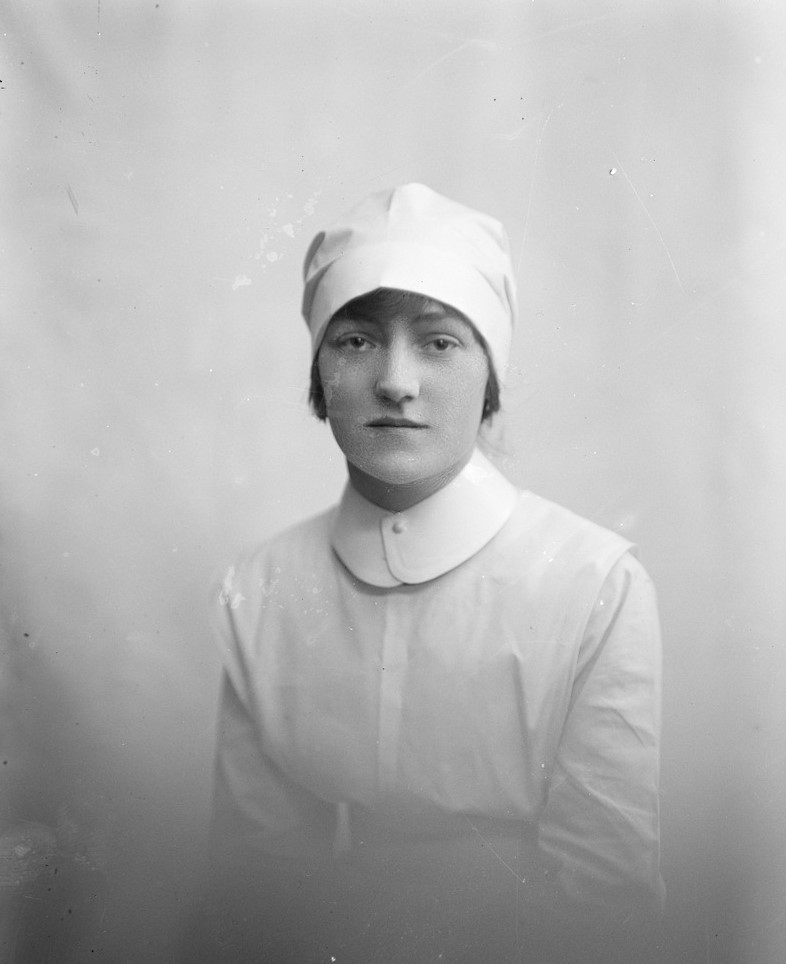
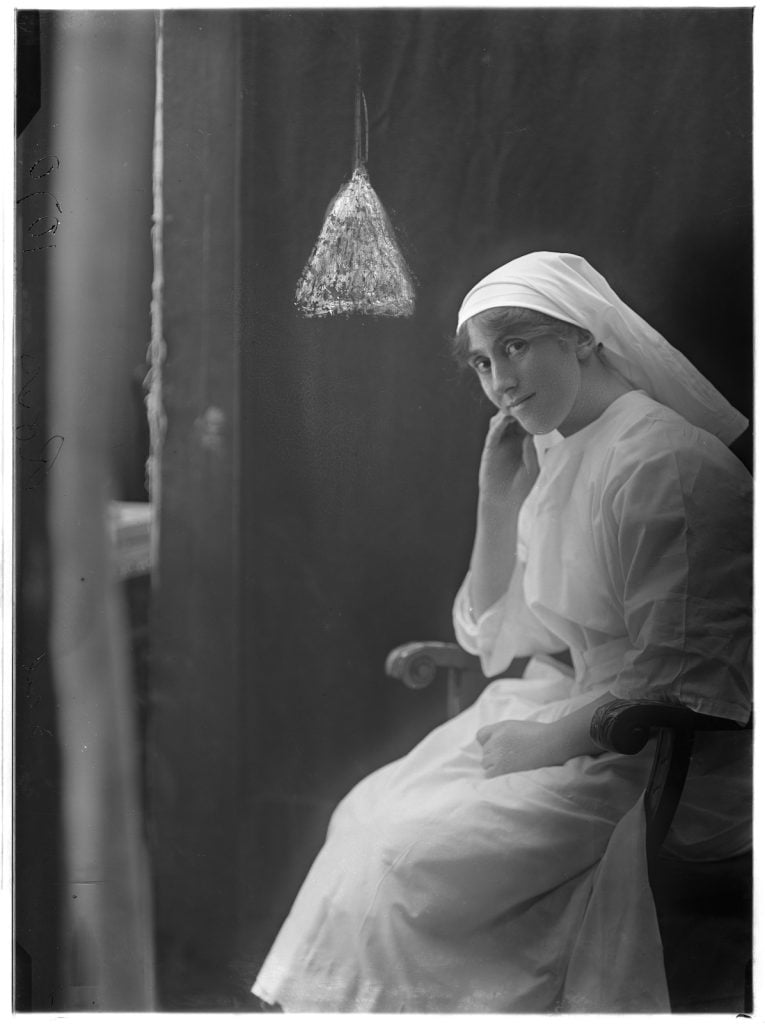
Studio portrait of young woman, possibly from the Ross family, [between 1904 and 1920?], H2017.74/92
The First World War threw many nurses into the forefront of patient care in the most challenging and confronting of circumstances.

H2018.15/126.
We are fortunate to hold the diaries and photographs of Alice Kitchin in our collections. Graduating in 1901, Kitchin was a foundation member of the Australian Army Nursing Service. After enlisting in 1914, she spent the war years in Egypt, Greece, France and England before returning to Australia on the HS Kanowna in 1919. Nursing staff and recovering soldiers photographed below at the No. 1 Australian Auxiliary Hospital, Harefield.

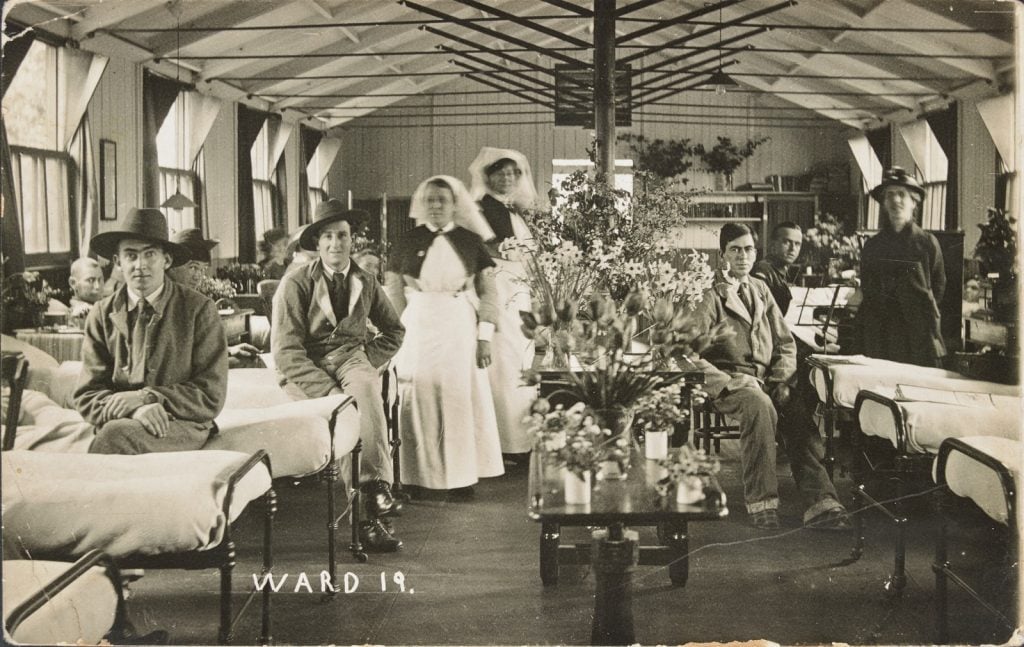
Wartime brought home to many the role and contribution of nurses as well as the challenges:
sometimes the nurse added, she felt like going into a corner and howling. But if good work is to be done one must not let the tragedy of war get on ones nerves…the tragedy is never far away; one has only to watch the unloading of a convoy in the dim uncertain light of the station; to see the stretcher bearers bringing their burdens out and putting them into the waiting ambulances; watch the ambulance going as gently as possible along roads broken up with heavy traffic and deep with slush and pools of rain…
‘Nursing in Boulogne‘, 1915, UNA: Journal of the Victorian Trained Nurses’ Association, vol 12, no 11, p 356
Another avenue of employment for nurses was to establish a private hospital themselves. Ruth Batterham (1878-1966) graduated from Melbourne Hospital in 1905 and from 1913 she ran a private hospital in Camberwell until circa 1937. Her brother Ernest and family lived in Bendigo.

[between 1910 and 1925?], photo by W. Vincent Kelly , H2018.319/57
Nurses applied their skills in a wide range of settings from country hospitals and wards in tents to hospitals treating patients with mental health issues.
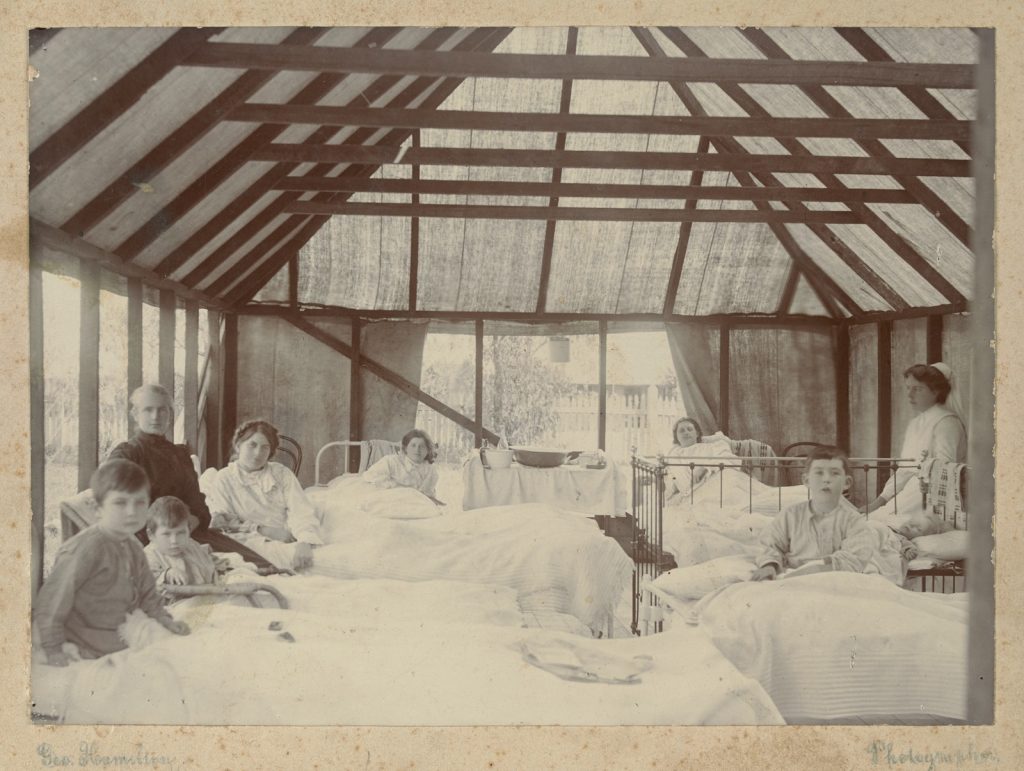

Collection of photographs relating to Mont Park Hospital, [ca. 1917], H2010.127/1-22
For those communities beyond metropolitan Melbourne, and without their own hospitals, such as Bendigo, nursing and medical care was difficult to come by. Envisaged by Lady Dudley, the bush nursing scheme through the Victorian Bush Nursing Association, set to work to address that gap. The Argus reported on a well-attended meeting held by the National Council of Women – ‘The scheme should be regarded as one to supply nursing wherever it was needed over it was needed. They knew the excellent work which the Melbourne District Nursing Association did. Lady Dudley wanted – and they wanted – to do work of the same kind further afield all through the country, both in settled lands, and in the bush (Hear hear).’
For varying time periods until 2011, 156 bush nursing hospitals operated around Victoria.6 Today, as health care is centralised, and transport and communications far more advanced, there are 5 hospitals and 15 centres operating alongside other health infrastructure. District nurses work to support patients in their homes, with visits to aid recovery and maintain connection with the hospital system.

The Royal Children’s Hospital was founded as the Free Hospital for Sick Children, in 1870 in Stephens – later Exhibition Street in the city. In 1876 the hospital moved to Rathdowne Street, Carlton, the former home of Redmond Barry, and then to Parkville in 1963.
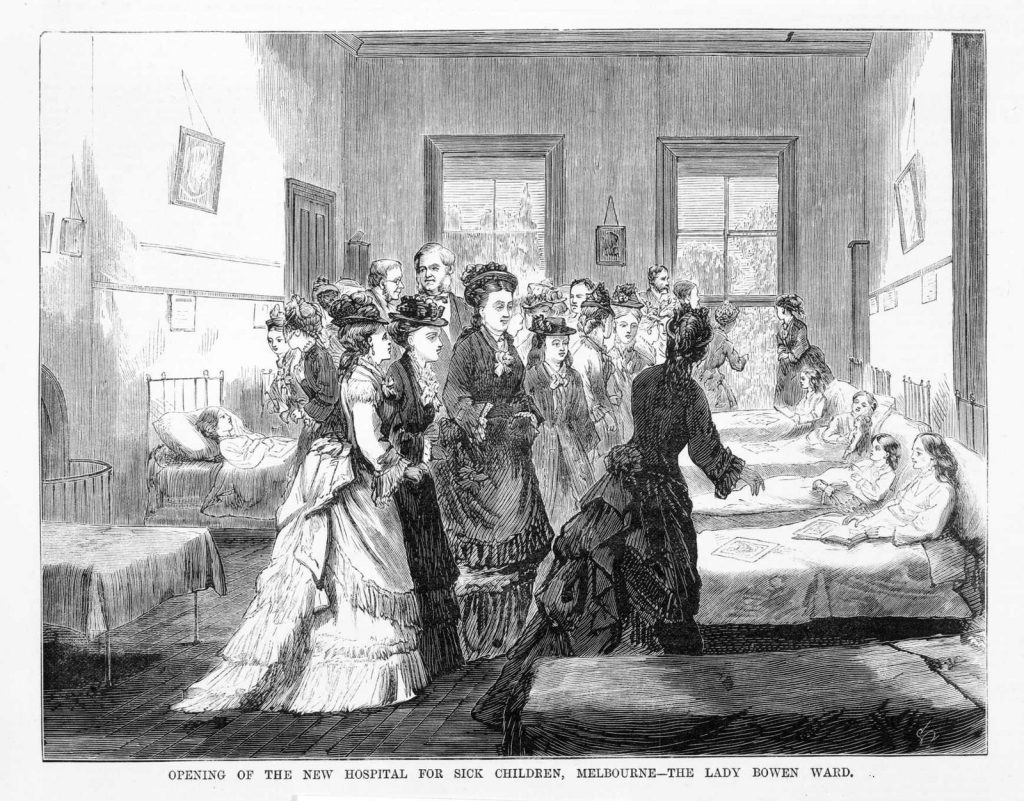
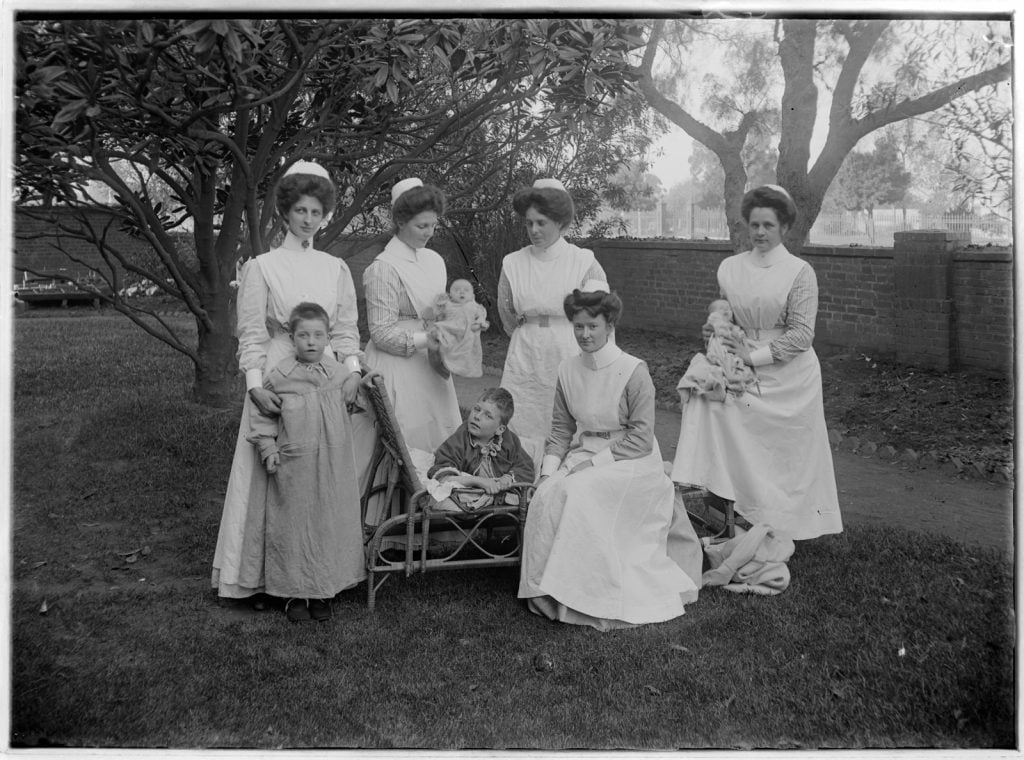
This image is of the Joy Cot, maintained by funds derived from the sale and performances of the Rose of Joy cantata written by Miss A. R. Rintoul, composed by Rev. Alfred Wheeler.
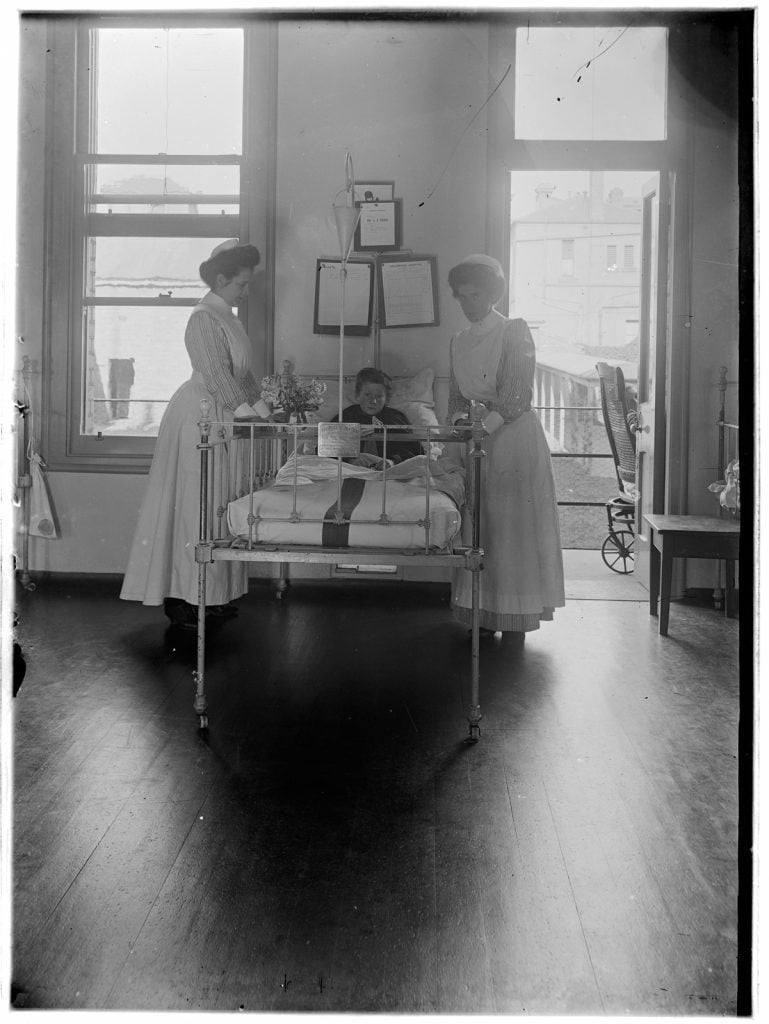
As part of the shift from the home to the hospital for childbirth, pupil midwives undertook a course of study at the Melbourne Lying-in Hospital from 1862, and as reported in The Argus, the study would be followed by a ‘strict examination [which] will of itself be a guarantee that the skill which is manifested within the hospital is made available when these nurses leave it for other parts of Melbourne, or for the country districts.’ From 1902, training was undertaken at the Women’s Hospital with a dedicated training school providing certificates in gynecological nursing and midwifery. St Andrew’s Hospital, East Melbourne operated from 1935 to 1985, below graduates from their first midwifery class in 1974.
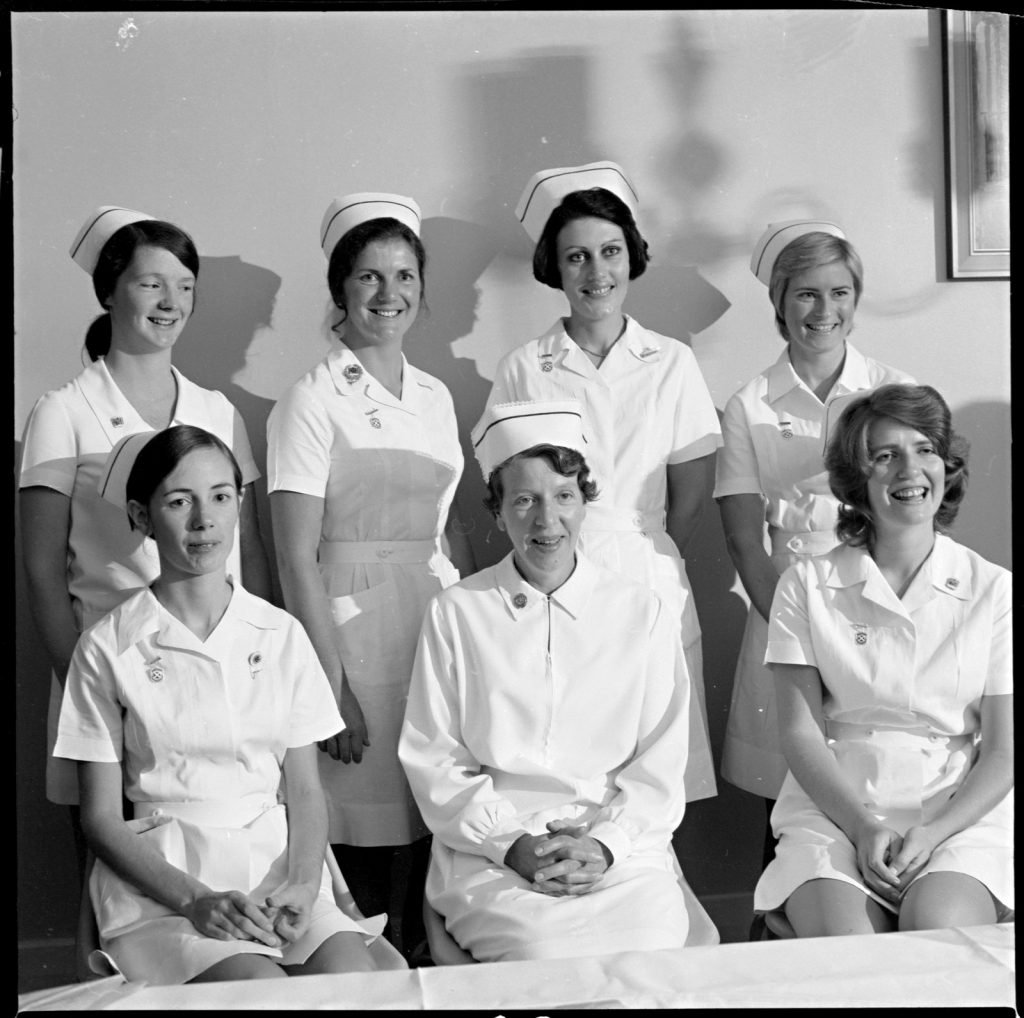
Dennis Mayor Collection of Photographs. This image is in copyright.
The Nursing Aide School for state enrolled nurses opened in October 1950. In operation until 1992, it offered another avenue into the profession. Women who had joined the workforce during World War 2, and newly arrived migrant women studied a shorter coures that enabled them to contribute to nursing work.
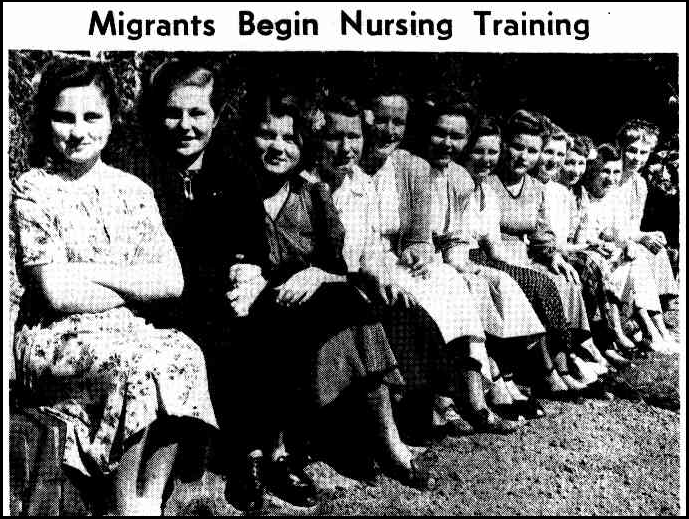
The long work hours, low pay rates and lack of professional recognition encouraged the formation of a range of organisations in support of nurses and to varying degrees, their claims. 7. The Royal Victorian Trained Nurses Association together with doctors, from 1902, was responsible for registering hospitals as training schools. Their journal, sought to be ‘devoted to the interests of the Association generally, it’s scope will necessarily be as wide as the Art and Science of nursing…to prove an educational and ethical influence …in the practice of a profession in the highest degree honorable and humanitarian.’ 8.

March 1904 March, Volume 2, Number 1
The Trained Nurses Guild, formed in 1922 intending to pursue nurses’ industrial aims and an award. The RVTNA discouraged nurses from joining the the Guild and while it gained registration through the Arbitration Court in 1922, insufficient support from nurses left it unable pursue its’ aims.9

As at the turn of the century, training a skilled and professional nursing workforce required fresh investigations. The commonwealth inquiry into nurse education and training, was commissioned in 1977 ‘to review arrangements for the education and training of nurses and to advise the Tertiary Education Commission on possible developments and changes, including whether the education of nurses should take place in hospitals or educational institutions or both.’ The recommendations led to the 1984 legislation supporting this transition out of hospitals into Colleges of Advanced Education.
The 1980’s were also a time of rising industrial tensions. Existing issues of low staffing levels and high patient loads were exacerbated by a new award which effectively reduced pay as positions were reclassified and qualification allowances withdrawn. The 50 day strike by nurses and midwives in 1986, was ultimately resolved with an agreement in the Industrial Relations Commission in January 1987.
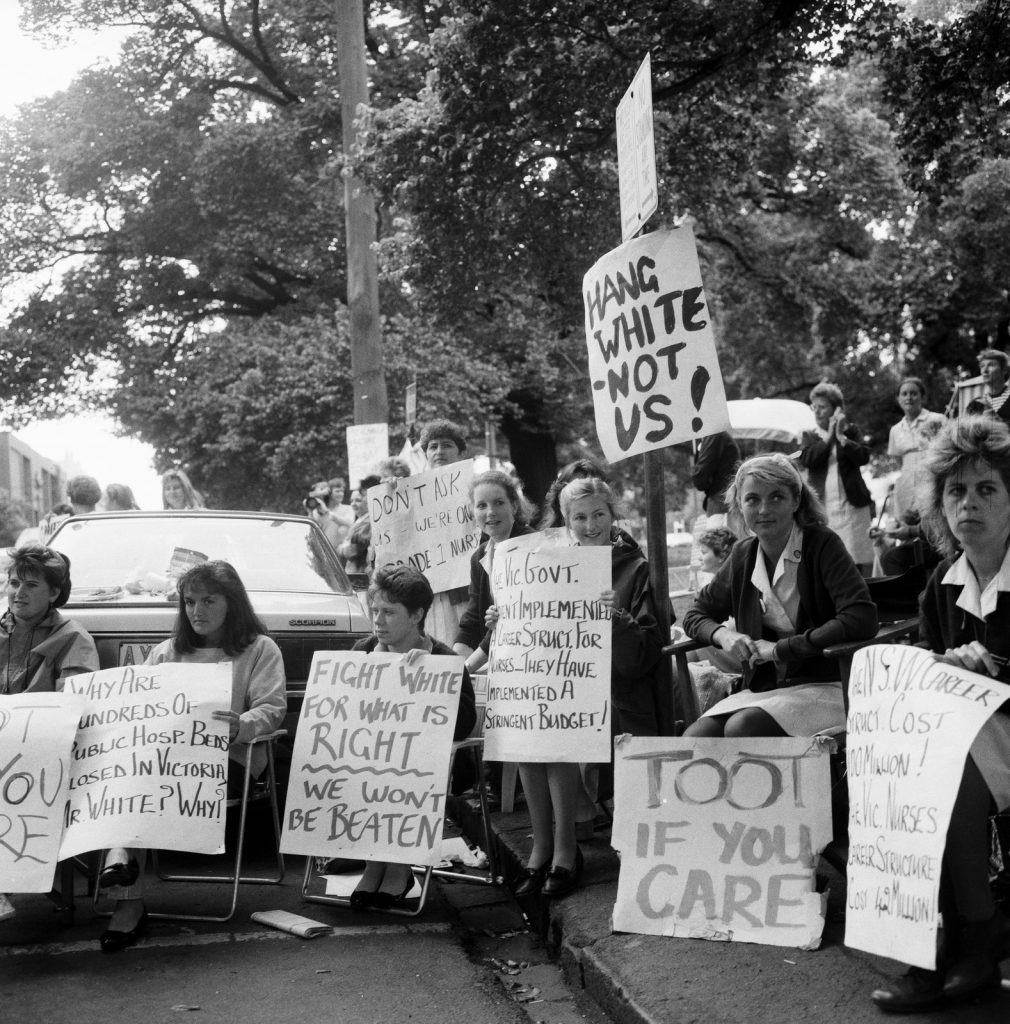
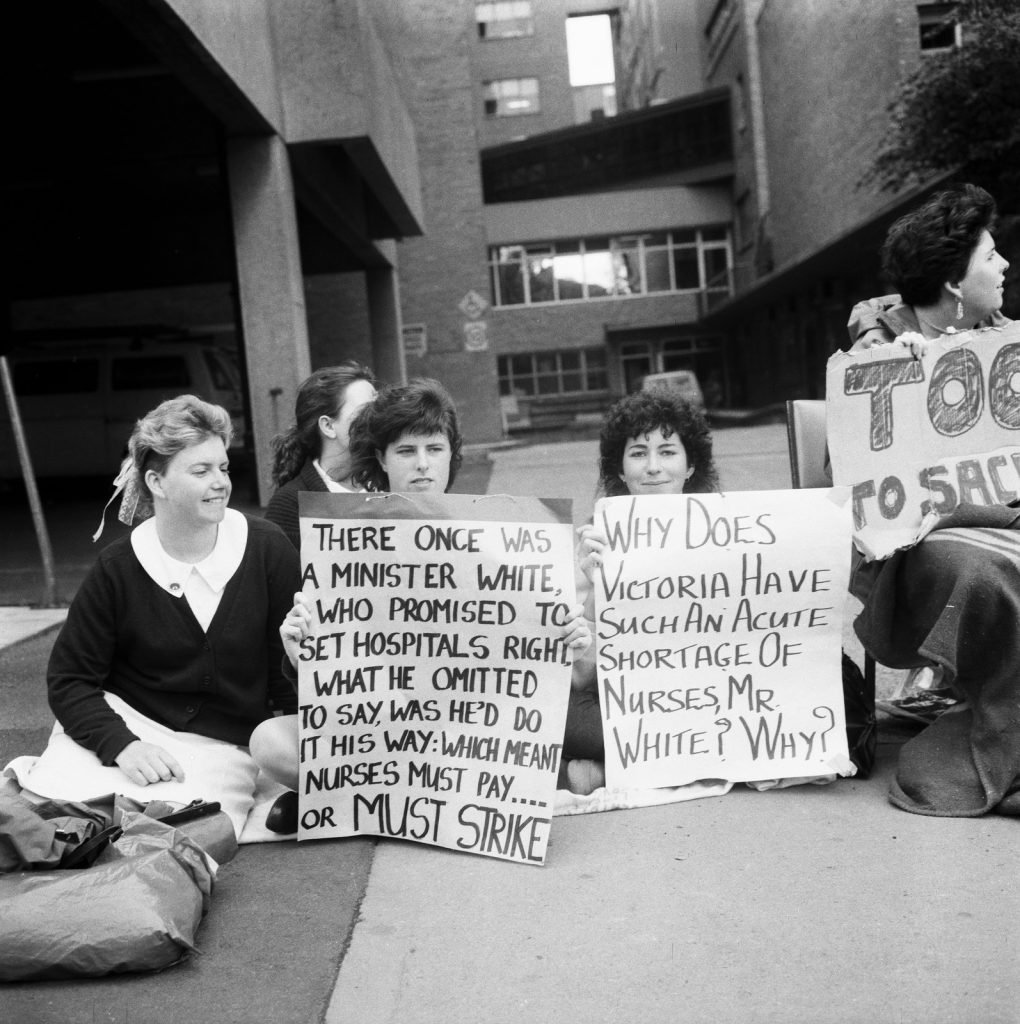
These images are in copyright.
Today, nursing is a degree course through the university sector, with increasing specialisation as the health system, medicine and technologies become more complex. The most recent review Educating the nurse of the future, investigated the training for enrolled nurses, registered nurses and nurse practitioners, the factors that lead to choosing nursing as an occupation, and an international perspective on Australian nursing education.
To our nurses and midwives, we say thank you for everything you do!
Further resources
Australian Nursing and Midwifery Federation
Cushing, Angela, 1993, A contextual perspective to female nursing in Victoria, 1850-1914, Geelong, Deakin University
History of nurse education in Australia (Australian College of Nursing)
Nurses and midwives (Victorian Genealogy)
Researching Australian nurses in World War 1 (SLV Research guide)
Researching your ancestors occupations – Health (SLV Research guide)
Royal Australian Nursing Federation (University of Melbourne Archives)
Pearson A., Taylor, B., and Coleborne, C., 1997, The nature of nursing work in colonial Victoria 1840-1870, Geelong, Vic. : Deakin University Press
Priestly, Susan, 1986, Bush nursing in Victoria 1910-1985 the first 75 years, Melbourne : Victorian Bush Nursing Association in conjunction with Lothian
Schultz, Bartz, A tapestry of service, The evolution of nursing in Australia
UNA: Journal of the Victorian Trained Nurses’ Association (available online, 1903-1976)
References
- Nightingale, Florence, Notes on nursing: what it is and what it is not, 1946, Philadelphia, J.P.Lipincott and Company.
- Sherson, Susan, Being there, 2005, [Parkville, Vic.] : Royal Melbourne Hospital Graduate Nurses Association, p 7
- Self-reliant women, The Tasmanian, 7 May 1887, p 15
- eMelbourne, Sioban Nelson and Madonna Grehan, Nursing, accessed 26 April 2023, <https://www.emelbourne.net.au/biogs/EM01071b.htm>
- Collins, Yolande and Kippen, Sandra, 1998, Aprons and arches: A history of Bendigo Hospital trained nurses 1883 to 1989, Bendigo, Vic. : Holland House, p 3
- Centenary of First Bush Nursing Facility, Monument Australia., viewed 8 May 2023,
- Bessant, Judith and Bessant, Rob, 1991, The growth of a profession. Nursing in Victoria, 1930’s-1980’s, Bundoora, La Trobe University Press, pp xxii-xxiv
- UNA: Journal of the Victorian Trained Nurses’ Association, 1902, vol 1, no 1 April 1903, p 1
- Bessant, Judith and Bessant, Rob, The growth of a profession. Nursing in Victoria, 1930’s-1980’s, 1991, Bundoora, La Trobe University Press, pp xxii-xxiii


Thank you this is very useful information and I’ve bookmarked for future reference. Have you checked the list of members in the UNA Journal vol 11 no 4 June 1913? There is a nurse Ross with an address in Bendigo. The date after the address is generally the date of the exam result and Nurse Ross’s exam possibly preceded the listing of results that regularly appeared in newspapers
Hello Kathleen – thankyou for your comments – I’m glad you found it useful. Thanks too for the tip on Nurse Ross – I have added that information in above. I will look at the lists in UNA – there are a few other nurses in the Kelly/Rosenberg collection which might appear there.
Best wishes, Jane
How ironic that in 1927 there was a newspaper report on the poor wages for nurses. And here we are in 2023 with my Granddaughter pulling beers in a hotel and being paid more than her sister with two nursing degrees. When will it change?
Hello Anne – that is certainly hard to understand – that struggle for nurses is well documented from early days. Best wishes to both your granddaughters – I hope they both enjoy their work.
I have always been fascinated by the story of Florence Nightingale. This is a great article for my term paper. Thank you very much.
The nurse, Eileen Mary Spicer is in fact my mother. She met my father who was a Resident Medical Officer at Bendigo Hospital and returned from service on the WesternFront. They married and had 5 children of which I am the youngest (now 82).How incredible ?
Hello Edward – how wonderful! Thank you for letting us know and hope that this portrait can add to your collection.
Best wishes, Jane
I have a copy of my grandmothers sisters nursing certificate in Victoria in the name of Mary Alfrieda Padley dated 26/01/1926 just wondering if it would have any use to any nurses history anywhere ?
Hi Christine, thanks for your comment. If you’re interesting in donating the certificate to the State Library, please fill in the following form and our collection librarians will be in touch with you to discuss further. The Australian Nursing & Midwifery Federation (Victorian Branch) Library may also have an interest as their collection includes historical material related to nursing in Victoria.